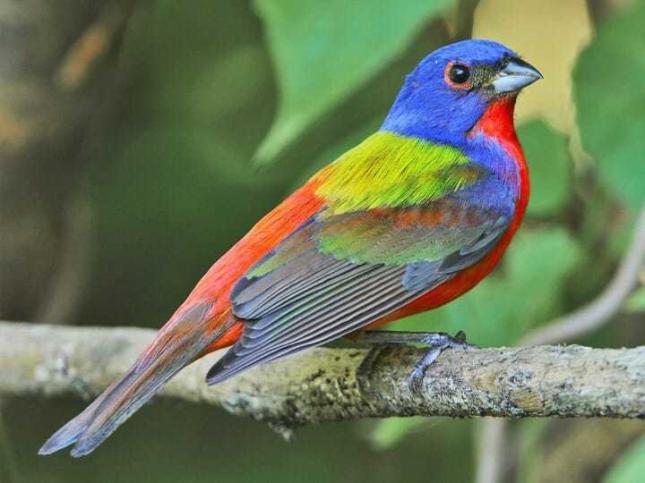Winged Wildflowers: Don't Miss the Spectacle!
The first half of April has been, for the most part, cool and cloudy. Most of us have yet to put away our winter coats; in fact, we continue to wear them. There are hints of Spring in the air, but it’s been difficult to get overly excited when windows are still shut tight, furnaces are still pumping at night, and everyone’s case of “Spring Fever” seems more severe and prolonged this year--especially after we had to reacquaint ourselves with several accumulating snowfalls and weeks of sub-freezing weather, following a string of very mild winters.
Fortunately, all of that is about to change. And our feathered friends (who time their journeys more by length of daylight than by weather) are en route to tell us so. While I suspect everyone looks forward to the arrival of Spring, few appreciate it as much as birders and wildflower aficionados (known also as anthomaniacs.) Woodland wildflowers are their showiest in April, as that is when sunlight reaches the forest floor, before the trees leaf out. This time of year, Trout Lilies, Trilliums, Virginia Bluebells, Wood Sorrels, Columbines, and many more ephemeral blooms pop up through the leaf litter and brighten the sylvan ground with a breathtaking palette of color. However, in just a few short weeks, those stunning hues will be shaded out, and these fleeting perennials will go dormant until next Spring. 
Similarly, migrant songbirds (passerines or “perching birds”) return each Spring wearing their boldest, brightest shades of plumage. Since we in the Mid-Atlantic tend to see them only during the warmest time of year, when they are at their most colorful, we can easily overlook the fact that these brilliant suits are worn for just a few short months, as special “formalwear” for the breeding season. The truth is that a male tanager is only scarlet for 4-5 months of the year and wears almost no red for 7 months out of 12! However, we rarely see them in anything but breeding plumage.
The majority of passerines undergo a complete body molt in the late summer or early fall—after the labor-intensive breeding season but before the physical exertions of southbound migration. (Replacing feathers takes a lot of energy, so it generally occurs outside of other periods of high-energy demand.) For birds like buntings, tanagers and most of the warblers, that is when they morph into their drab “basic” (non-breeding) plumage—a potentially life-saving shift into camouflage clothing which they don for 6-8 months, until early Spring. Indeed, as many a frustrated birder knows, identifying fall warblers in the field can be quite the challenge, once they’ve replaced most of their striking yellows and greens with dull olive and gray feathers.
Whereas many types of songbirds just molt annually, these particular species undergo a second, partial molt of their body (contour) feathers (but generally not wing and tail feathers), prior to heading north again. In the case of the males, this gives them their elegant breeding attire (known as “alternate” plumage), which is so crucial to attracting a mate and fending off conspecific competitors once upon their breeding grounds.
If it is difficult to accept that “scarlet” is the “alternate” plumage for a tanager, think of the more ubiquitous goldfinch. An exception to the molting norms, goldfinches undergo two complete (flight feathers, too) body molts per year (as do Bobolinks), despite not being a migratory species in our area. They’re here year-round, yet the males are really only “gold” for about a third of that time, with muted tones being the norm all winter. Once bright yellow patches begin to return, as they’ve been doing for the past few weeks, we’re thrilled, knowing that Spring is right around the corner.
Most of our Neotropical migrants are currently well into their two- to six-thousand-mile treks back from Central or South America. You can follow their progress (and know when to anticipate their return) by visiting online resources like BirdCast and eBird. And many of them recently underwent that partial molt, restoring their most stunning and intense coloring just in time for their return to our region. Fortunately for us, they go right into breeding mode as soon as they get here, which means their arrival will be announced by an abundance of birdsong! Particularly during the last week of April and much of May, get outside and turn on the Merlin app on your phone! (If you do NOT already have this sound-recognition app installed, you are really missing out.) Just as we’re currently in that narrow window of time for appreciating ephemeral wildflowers at their most beautiful, the month ahead will bring birds—scads of them—through the region when their colors are most striking and they’re more vocal than any other time of year. You won’t want to miss it!
Feel like a bit of a technological dinosaur among birders because you aren’t proficient with tools like Merlin, eBird or BirdCast? We will be holding coaching sessions this summer in both our Columbia and Timonium stores, to introduce these fabulous new resources that are changing the way bird enthusiasts find birds, identify them, and share what they’ve encountered in the field. If you are interested in attending, please email [email protected] for further details.
